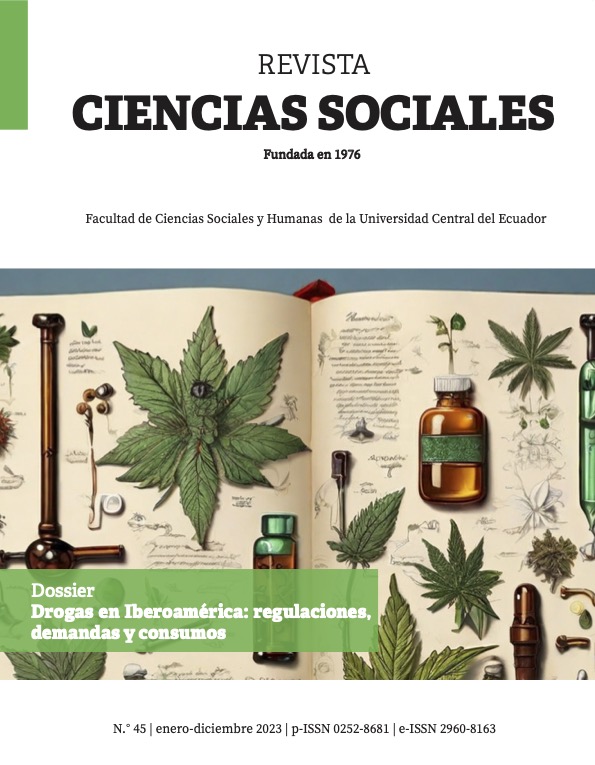Smoke it to legalize!
Contributions of Ecuadorian music in the deconstruction of the hegemonic discourse on marijuana
DOI:
https://doi.org/10.29166/csociales.v1i45.5391Keywords:
Marijuana, recreational consumption, Ecuadorian music, cannabis musicAbstract
The article analyzes how independent Ecuadorian music songs question the official discourse on marijuana -associated to crime and delinquency- to produce new aesthetics, politics, and ethics, around its nature and consumption, which generates collective tensions and resistance that go beyond the musical field. Methodological tools of autoethnography were used to select 5 songs: "Ojos que matan", "Sangre Cannabinol", "María (La Wirsh), "Coima", and "Santa Mariguana"; each one corresponds to a different musical genre. We analyze: 1) authorship, musicians, band's trajectory; 2) the aesthetics of the cover, clothing and performance; 3) the lyrics, especially the part that alludes to marijuana; and, 4) how these aesthetics and lyrics are interpreted as questioning the political and media truth, to provide new frameworks of interpretation to a prohibitionist discourse established in absolute truths; but which is opposed to the subjective and collective experiences of marijuana consumption in musical contexts, and, therefore, loses its objective character.
Downloads
References
Bellón, M. (2018). El abc del Rock. Todo lo que hay que saber. Bogotá: Editorial Debolsillo.
Blanco, M. (2012). ¿Autobiografía o autoetnografía? Desacatos, 169-178.
Caiuby Labate, B., & Rodrígues, T. (2023). The impacts of the drug war on Indigenous Peoples in Latin America: An overview. Akademiai Kiadó Journal of Psychedelic, 1-9.
Delgado, E. (1971). Onsta la Yerbita [Grabado por L. Destellos]. Lima, Perú.
Godoy Aguire, M. (2018). Pasiilo: historia, innovación e impacto. Quito: Casa de la Cultura Benjamín Carrión.
Gortaire, F. (2008). Coima [Grabado por K. M. Langolier]. Quito, Ecuador.
Idrovo, H. (2013). Santa Mariguana [Grabado por H. Idrovo]. Quito, Ecuador.
Inti-Illimani (1971). La Cucaracha. Santiago de Chile, Chile.
Jaramillo, J. (1970). Ojos que Matan.
Moscovici, S. (2003). Notas hacia una descripción de la representación social. Revista Internacional de Psicología Social, 1(2), 67-118.
Muller, C., & Schumann, G. (2011). Drugs as instruments: A new framework for non-addictive psychoactive drug use. Behavioral and brain sciencies , 293- 347.
Muscaria (1998). Sangre Cannabinol. Quito, Ecuador.
Ramírez, P., Marín, I., Hijonosa, M., & Torres, Á. (2023). La prensa ecuatoriana y el tratamiento que da al cannabis. Rimarina: Revista de Ciencias Sociales y Humanidades, 38-45.
Real Academia de la Lengua Española RAE. (21 de Agosto de 2023). Definición de Droga. Obtenido de Diccionario de la Lengua Española: https://dle.rae.es/droga
Real Academia de la Lengua Española RAE. (2023 de Agosto de 2023). Definición de Marihuana. Obtenido de https://www.rae.es/dpd/marihuana
Reynolds, S. (2010). Después del Rock: psicodelia, postpunk, electrónica y otras revoluciones inconclusas. Buenos Aires: Caja Negra.
Rodríguez Mera, A. (2023). Dos visiones mediáticas, un objeto de regulación: legitimación para unos, criminalización para otros. Quórum Académico, 14-48.
Rodríguez, A. (2022). La vida social del cannabis. Disputas públicas y colectivas por derechos. Política y Sociedad, 2-14.
Scribano, A., & de Sena, A. (2009). Costrucción del conocimiento en latinoamérica: algunas reflexiones desde la autoetnografía como estrategia de investigación. Cinta Moebio, 1-15.
Shapiro, H. (2010). Historia del Rock y las Drogas. Barcelona: Ma Non Troppo.
Sudakaya (2003). María (La Wirsh). Ambato, Ecuador.
Tenorio R, R. (2013). Ecuador y la Marihuana. Quito: Editorial El Conejo
Published
How to Cite
Issue
Section
License
Copyright (c) 2024 Fernando Endara Ibarra

This work is licensed under a Creative Commons Attribution-NonCommercial 4.0 International License.
Política de acceso abierto
La revista Ciencias Sociales adhiere al modelo Acceso Abierto en el que los contenidos de las publicaciones científicas se encuentran disponibles a texto completo libre y gratuito en Internet, sin embargos temporales, y cuyos costos de producción editorial no son transferidos a los/las autores/as.
En ese sentido, no existe costo alguno para los/as autores/as en el envío o durante el proceso editorial, defendiendo el derecho a la información con equidad e iguales oportunidades de acceso.
Licencia y derechos de autor/a
Los autores conservan todos los derechos de publicación del artículo y conceden a la Revista Ciencias Sociales una licencia no exclusiva, intrasferible y sin regalías por duración ilimitada para su reproducción, distribución y comunicación pública a nivel mundial bajo una Licencia Creative Commons Atribución 4.0 Internacional (CC BY NC 4.0)


